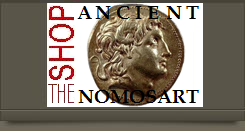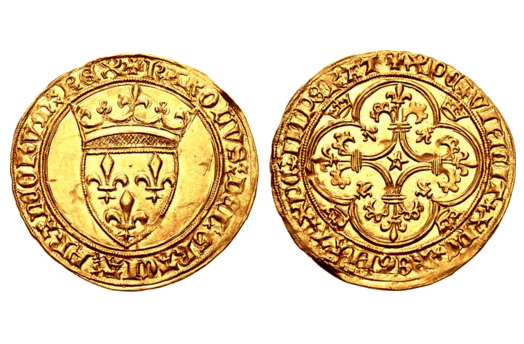
about ancient nomos
Ancient Nomos Art is a museum of galleries exhibiting ancient coins and ancient mint maps. The coin gallery displays the diverse art and history of hand-crafted ancient Greek, Roman, Byzantine, Persian and Medieval coinage. The ancient mints mapping gallery features Greek, Roman, Byzantine, Asia Minor and Medieval mint city regions and territories. Visitor's are welcome to explore, study and enjoy Ancient Nomos Art.

Medieval France – 1388 AD
Charles VI "le Fol"
From Ancient Galleries

Obverse: Medieval France coat-of-arms shield topped by the Valois royal crown.
Reverse: Arched croix arquee (cross) over arched cross fleurée all in quadrilobe.
LEGEND
Obv: + KAROLVS : DЄI : GRACIA : FRAnCORVm : RЄX (double saltire stops), central coat-of-arms shield (ecu) of France with three fleur-de-lis, topped by the royal crown. Rev: + XPC • VIИCIT • XPC • RЄGИAT • XPC • IИPЄRAT (mullet stops), voided short arched cross potent (croix arquee) over arched cross fleurée; mullet at center; all within quadrilobe, with inward-facing lis in each arch and crown in each spandrel.
King Charles VI of France, sometimes called le Fol (the mad), or le Bien-Aimé (the beloved), was born in Paris on December 3, 1368. His father was King Charles V, a member of the House of Valois. His mother was Joan of Bourbon. After his father’s death, a youthful Charles VI, only eleven years old at the time, became King of France. He was officially crowned king at the cathedral of Reims in 1380. He reigned as monarch from 1380 to 1422, but did not take full command as king until 1388. Prior to taking charge, France was essentially governed by his uncle, Philip the Bold, Duke of Burgundy. In 1385, Charles married Isabeau de Bavière (of Bavaria). Isabella had eleven children with Charles. Charles VI’s reign was marked by the continuing conflict with the English, known today as the Hundred Years’ War. In 1385, Charles VI declared a new gold coin of France would be created with a precise weight and high level of purity. He declared new coinage would fund a treasury that was depleted by his uncle, bolster the economy, renew confidence, and increase the state resources in order to fight the English. The new gold coins are known today as écu d’or a la couronne, or more commonly known as “shield” coins. The new coin designs combine decorative motifs with iconic royal images, each symbolic of France. This was a departure from the previous coinage that figuratively represented the king’s image and his stately medieval castle. The new écu d’or a la couronne coin symbols included the coat-of-arms (écu or shield) of France, fleur-de-lis images, royal crowns, the Christian cross potent (croix arquee), a cross fleurée, mullets, quadrilobe designs, arches and additional smaller size crowns. The new écu also revised the old benediction legends. The gold écu coins were issued in two general phases, type one and type two. The first phase, type one, were coins bearing no mint marks. The second phase, type two, were coins issued with secret dots to indicate the mint city. The écu type one (without mint marks) is considered the king’s first gold issue and were struck for four years, between April 11, 1385 and September 11, 1389. The above écu is a type one issue, noted for having an undisclosed mint origin or mintmark. The coins obverse depicts the écu or central coat-of-arms (shield) of France with three fleur-de-lis engraved inside. The shield is topped by the king’s crown. The Latin legend abbreviations on the obverse: KAROLVS : DЄI : GRACIA : FRAnCORVm : RЄX, translates to mean, “Charles, by the Grace of God, King of the Franks.” Each obverse Latin abbreviation is spaced by medieval punctuation type called double saltire stops. The coins reverse depicts an arched cross potent (croix arquee) over an arched cross fleurée with a mullet in the center. The cross designs are all framed within a quadrilobe with inward-facing fleur-de-lis in each arch and a small king’s crown in each spandrel. The Latin legend abbreviations on the reverse: XPC • VIИCIT • XPC • RЄGИAT • XPC, translates to mean, “Christ Conquers, Christ Reigns, Christ Commands.” Each reverse Latin abbreviation is spaced by medieval punctuation type called mullet stops. The new écu coinage of Charles VI was very successful and the design survived relatively unchanged until the reign of Louis XIV. In 1389, Charles VI ordered a second type issue that required each mint to engrave a “secret dot” under a specific letter of the legend to indicate its origin was France. This was primarily done to combat Henry V of England distributing his own imitative gold coinage into northern France during the wars. In 1396, as an attempt to reconcile with England, Charles VI offered his seven-year-old daughter, Isabella of Valois, a hand in marriage to England’s 29-year-old Richard II, the son of Henry V. By the turn of the century, France was rife with chaos, civil strife and royal infighting between the Armagnac’s and the Burgundian’s. During this time, England took advantage once again by invading northern France. Henry V of England defeated the army of Charles VI at the Battle of Agincourt in 1415, but the Hundred Years’ War would continue for another half century. Charles VI died in 1422 and is interred with his wife Isabeau in the Basilica of Saint Denis in Paris.
DOCUMENTATION
Value: Écu d’or a la Couronne. Metal: AV Gold. Weight: 3.99 grams. Mint: Unknown. Date: Struck during 2nd emission, 28 February 1388 – 11 September 1389 AD.
Attribution: F. Ciani, Les Monnaies Royales Françaises de Hugues Capet à Louis XVI, 486; J. Lafaurie & P. Prieur, 378; J. Duplessy, Monnaies Françaises Royales, I, 369A; Friedberg 291. Photo courtesy CNG.
Legend, Documentation and Attribution
